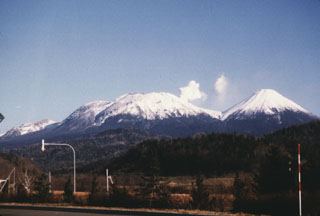Report on Akan (Japan) — January 1988
Scientific Event Alert Network Bulletin, vol. 13, no. 1 (January 1988)
Managing Editor: Lindsay McClelland.
Akan (Japan) Ash eruption; low-amplitude tremor
Please cite this report as:
Global Volcanism Program, 1988. Report on Akan (Japan) (McClelland, L., ed.). Scientific Event Alert Network Bulletin, 13:1. Smithsonian Institution. https://doi.org/10.5479/si.GVP.SEAN198801-285070
Akan
Japan
43.384°N, 144.013°E; summit elev. 1499 m
All times are local (unless otherwise noted)
Ash-darkened snow near the summit of Me-Akan-dake was reported by Kushiro Local Meteorological Observatory staff on 7 January. The ashfall area stretched 2,000 m NE from Ponmachineshiri Crater and was 900 m wide. The ashfall was presumed to have resulted from an eruption that began the evening of 5-6 January. Continuous tremor of low amplitude was recorded from 1715 on 4 January through 0300 on 6 January . . . .
Fumarolic activity at Ponmachineshiri Crater had been noted by a field survey in May 1987 and fumarole temperatures began increasing in July. Earthquake swarms have occurred frequently since December when the monthly total of recorded earthquakes reached 394.
Geological Summary. Akan is a 13 x 24 km caldera located immediately SW of Kussharo caldera. The elongated, irregular outline of the caldera rim reflects its incremental formation during major explosive eruptions from the early to mid-Pleistocene. Growth of four post-caldera stratovolcanoes, three at the SW end of the caldera and the other at the NE side, has restricted the size of the caldera lake. Conical Oakandake was frequently active during the Holocene. The 1-km-wide Nakamachineshiri crater of Meakandake was formed during a major pumice-and-scoria eruption about 13,500 years ago. Within the Akan volcanic complex, only the Meakandake group, east of Lake Akan, has been historically active, producing mild phreatic eruptions since the beginning of the 19th century. Meakandake is composed of nine overlapping cones. The main cone of Meakandake proper has a triple crater at its summit. Historical eruptions at Meakandake have consisted of minor phreatic explosions, but four major magmatic eruptions including pyroclastic flows have occurred during the Holocene.
Information Contacts: JMA.

